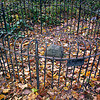
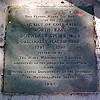
Howdy, pilgrim! You're in volume 0.50 of the ^zhurnal — see ZhurnalWiki on zhurnal.net for a parallel "live" Wiki edition; see Zhurnal and Zhurnaly for quick clues as to what this is all about. (Briefly: it's the journal of ^z = Mark Zimmermann ... previous volume = 0.49 ... complete list at bottom of page ... send comments & suggestions to "z (at) his (dot) com" ... tnx!)
The District of Columbia is a diamond-shaped square, ten miles on a side. In 1791-92 Andrew Ellicott, with Benjamin Banneker and colleagues, slashed through the wilderness, surveyed the bounds of the Federal City, and placed marker stones every mile along the edge. Many of these forty historic stones yet survive. My self-imposed quixotic mission: visit them, photograph them, and record their GPS coordinates. See [DC Boundary Stones] for a Google Map of the results. (The associated [XML file] contains the latitude and longitude information which generates that map.) Click on a thumbnail for a higher-resolution photo; click on the link at the end of a caption to see a guide map to that location.
 |
This stone marks the original northernmost point of the District of Columbia. It resides just south of East-West Highway, half a block west of 16th Street. [4] | Northeast Stone 1 has been removed; its former location is indicated by this plaque embedded in the sidewalk in front of a small store near downtown Silver Spring. [5] |  |
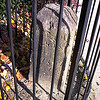 |
In Takoma Park, Northeast Stone 2 stands by a driveway on Maple Avenue just north of Carroll Street. [6] | Just south of New Hampshire Avenue, Northeast Stone 3 is in sad condition. The protective fencework around it has been mutilated, perhaps by trucks backing into it from the adjacent parking lot. The marker itself is surrounded with trash. [7] | 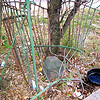 |
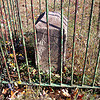 |
Northeast Stone 4 is found near a bus stop in the side yard of a house at the corner of Sargent Road and Eastern Avenue. [8] | The engraved lettering of Northeast Stone 5 has been carefully blackened in to make it more readable; perhaps it has also been re-engraved. The stone rests in the front yard of a home at 4609 Eastern Avenue. [9] | 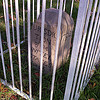 |
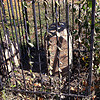 |
Northeast Stone 6 is protected by an ivy-clad fence in the front yard of a home on the corner of 34th Street and Eastern Avenue. [10] | Northwest Stone 9 is nestled beside a driveway leading down from Oregon Avenue to a home at the edge of Rock Creek Park. [11] | 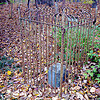 |
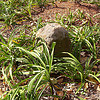 |
Northwest Stone 8 is situated in the middle of a small circular garden in the front yard of 6422 Western Avenue. [12] | Northwest Stone 7 is in the front yard of a private residence at the corner of Cedar Parkway and Western Avenue. It bears a descriptive plaque placed by the DAR. [13] | 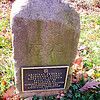 |
(Note that my GPS coordinates may be in error by several meters. For excellent information on the stones see Mark Kennedy's site http://www.boundarystones.org/ . Many thanks to comrade Jimmy H. for geo-historical reference materials and encouragement; cf. Boundaries of the United States and the Several States, US Geological Survey Professional Paper 909 by Franklin K. Van Zandt (1976); Washington Post article "Lesser-Known Monuments Map Out the Original D.C." by Steve Twomey (9 Oct 1990); Tom Howder's [travel adventure pages]; the Daughters of the American Revolution's [DC boundary stone page] and [Boundary Stone Locations page]; Mike Pegg's blog "Google Maps Mania" [17] in "Sunday Google Maps Assortment" [18] (27 Nov 2005); my collection of waypoints for [DC Metro Area Trails]; and Google Map Experiments (11 Sep 2005), Rock Creek Trail Miles 0 To 4 (26 Sep 2005), ...)
- Sunday, November 20, 2005 at 07:04:59 (EST) revised 15 Apr 2006
| Plan for the future — Work in the present — Learn from the past |
(cf. Plans And Situations (13 Aug 1999), Too Slow And Too Fast (25 Sep 1999), Touching The Void (2 Jun 2004), ...)
- Saturday, November 19, 2005 at 13:37:50 (EST)
My favorite words of wisdom from The Wiki Way:
Our conclusion from all this? A successful discussion server must be easy for its participants to use. All other potential powerhouse features are likely to be orders of magnitude less important, especially if they require extra software to be installed. A second critical factor must be the ability to easily refer to (link to) other "items", of whatever kind.
(from Bo Leuf & Ward Cunningham, The Wiki Way: Quick Collaboration on the Web (2001), page 11; cf. http://leuf.net/ww/tww ...)
- Thursday, November 17, 2005 at 05:25:48 (EST)
John Fowles died on 5 November 2005. After reading his obituaries in the papers I snagged a copy of The Magus when it surfaced at a charity used-book sale a few days ago. It's embarrassing to have to say anything negative about the recently deceased, but unfortunately Fowles is right in his self-criticism when in the Foreword he dismisses his first novel as a "... haphazard and naïvely instinctive work ...". And I was ready, by the time I reached Chapter 15, to agree with his title character who refuses to read any fiction and who monologues, "The novel is dead. As dead as alchemy. ... Why should I struggle through hundreds of pages of fabrication to reach half a dozen very little truths?"
In the case of The Magus, alas, I couldn't answer that question. I began to skim for naughty bits but couldn't discover enough of those to maintain my interest. In this book Fowles's narrative engine seems to doggedly chuff along a single set of tracks, hauling a heavy freight of allegory and archetype, literary allusion and juvenile angst. Not even an empty boxcar for this old hobo to hitch a ride in. Maybe I'll find the next train more accommodating ...
- Tuesday, November 15, 2005 at 21:43:27 (EST)
The contest between pride and modesty ends in a dead heat: I can't resist wearing my finisher's medal all the way home, but I put it inside my shirt when I go into a store to pick up something for tonight's dinner.
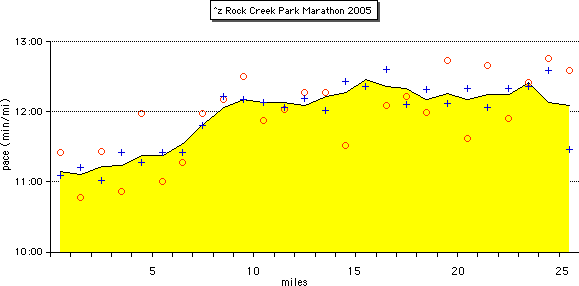
("Raw Pace" (circles) = split information for each mile ... "smoothed" (plus signs) = pace averaged over adjacent miles ... "smoother" (filled area) = further re-averaged pace data)
The inaugural Rock Creek Park Marathon & Relay today is a slightly startling success for me: I finish in 5 hours 13 minutes, without significant chafing, blistering, or soreness. (I do have one questionable toenail, but that's a "footnote" (^_^)!) It's the first long race I've undertaken since last March, when the Unfortunate Incident of the Toe in the Nighttime occurred. (cf. Bump In The Night (31 Mar 2005), Toe Transplant Project Zeta (1 Apr 2005), Torn Toe Tendon Repair (5 May 2005), etc.)
As usual I set two alarms to get me up on time but wake before either goes off. My breakfast of sub-champions consists of coffee and two high-calorie Dutch stroopwafels. As I dress I apply petroleum jelly liberally to every body part that's considered unmentionable (except among trail runners). By 6am I'm driving toward Lake Needwood, and in spite of getting slightly lost along the way I arrive by 6:30, park in a prime spot, and pick up my race packet without even having to wait in line. Besides my numbered bib and a excellent technical running shirt, the goodie bag also contains a small pouch full of brown rice. A few of us speculate whether we are supposed to eat the rice, feed it to the animals we encounter, or use it like breadcrumbs to mark our path through the woods.
Race day weather conditions are virtually perfect, cool and comfortable. As the sun rises I find comrade Evan, aka my "Speed Coach", who is doing a half-marathon as part of a relay team. We take pictures of each other and then I commence my customary pre-race walkabout. My hope (it doesn't deserve the dignity of being called a "plan") is to finish, without injury, within the six-hour cutoff. I've got plenty of excuses: my weak training regime for the past several months, my accident, the excess weight that I'm carrying, the hilliness of the course, etc. Gotta keep those expectations low! I am uncharacteristically calm and confident.
After some minor confusion is resolved (as to which side of the starting line we should stand on and which way the initial leg of the course is oriented) the pre-race announcements are made and we're off. I foolishly let myself get carried along at too fast a pace — I'm embarrassed to take early walk breaks within line-of-sight of so many cameras and fellow runners. As the chart shows, the first seven miles slip by significantly faster than my condition permits me to sustain. Then reality kicks in. I cut my pace significantly and implement a 1:1::jog:walk ratio, with bonus strolls whenever I see a hill looming ahead.
Half a dozen deer, does and fawns led by a five-point buck, amble across the path just in front of me. Geese honk on the lake and police motorcycles rumble as they cruise along the trail looking for racers in need of assistance. I introduce myself to Ina, a youthful triathlete from Hawaii who is doing a 13.1 mile relay leg and who hopes to run her first marathon in Honolulu at the end of the year. Ina says that she doesn't really enjoy running much; she's stronger as a swimmer. I catch up to and chat with Megan, a young woman undertaking her first marathon today. She tells me that her longest prior run was 18 miles. I refrain from suggesting that that's not usually long enough, and instead exhort her to keep her blood sugar up and stay optimistic. (Happily, I get to applaud Megan at the finish line when she comes in some minutes behind me. I take photos of her with her Mom, and suggest that her next marathon will be a lot more fun if she does a few training runs in the low 20 mile zone.)
Miles 16-18 are the low point of the day for me. But I force myself to eat and drink, I take an electrolyte capsule every hour, I continue the deliberate pace, and I tell myself that "no bad spell lasts forever". The magic works: before long I'm feeling chipper again. With only a handful of miles to go I pass a gentleman who's clearly suffering, reduced now to a stiff walk. He tells me he plans to drop out when he gets back to the parking lot at the lake. I check my watch and estimate that if he does the final two mile loop at a slightly faster pace than he's now walking, he should be able to make it under the cutoff and get a medal. (He perseveres and succeeds; we get to congratulate one another at the finish.)
Bottom line: the first half of the race goes by in 2 hours 32 minutes, but the second takes ~9 minutes longer, a suboptimal positive split. I doubt I could have broken 5 hours with proper pacing, but I could have come closer. Given the happy outcome today I suppose it's not time to hang up the jogging shoes quite yet. I'll take inventory and, if all still seems well in a few days, maybe I will sign up for the George Washington's Birthday Marathon in February and/or the Hinte-Anderson Trail run (a 50k ultra). I've enjoyed both in years past, and some friends are thinking about doing them; it might be jolly to try together.
Many thanks to Ron ("Tarzan Boy") Ely, RCPM&R race director, and all the others involved in putting on a superb event — the best marathon that I think I've been privileged to participate in! Special kudos to the volunteers in amazing polychromatic wigs, to the residents of Mulletville who shared their music and beer with me, and to all the kind people whom I was too befuddled to recognize but who helped me along the way.
(cf. Bless The Leathernecks (28 Oct 2002), Rocky Run (17 Nov 2002), Marathon In The Parks 2003 (11 Nov 2003), Washington Birthday Marathon 2004 (23 Feb 2004), Washington Birthday Marathon 2005 (20 Feb 2005), Seneca Creek Greenway Trail Marathon 2005 (5 Mar 2005), ...)
- Sunday, November 13, 2005 at 21:34:12 (EST)
Sir Arthur Eddington writes:
The search for physical reality is not necessarily utilitarian, but it has been by no means profitless. As the geometry became more complex, the physics became simpler; until finally it almost appears that the physics has been absorbed into the geometry. We did not consciously set out to construct a geometrical theory of the world; we were seeking physical reality by approved methods, and this is what happened.
(from Space, Time and Gravitation, Chapter XII (1920); quoted in part in "From This Angle, Geometry Rules the Universe" by K. C. Cole, Los Angeles Times (4 Nov 1999); cf. On Somethingness (17 Jan 2000), No Concepts At All (22 Feb 2001), ...)
- Saturday, November 12, 2005 at 08:04:03 (EST)
If wikis are so great for collaborative problem-solving and knowledge organization and emergent wisdom-making, then how come wikis aren't taking over the world of science?
Actually, they already have — for centuries now. But because the challenges of science tend to be orders of magnitude harder than those addressed in common wikis, the group-mind environments of science are likewise orders of magnitude slower than those of most online communities. The wikis of science are called journals and conference proceedings. The collaborative environments of science are called university departments and professional societies.
Maybe it's like the difference between flicking acorns to bring down a house of cards, and planting acorns to bring down a mountain ...
(cf. Expertise And Science (19 Feb 2001), Ten Thousand Hours (20 Sep 2001), Key To The Treasure (23 Apr 2004), Tools To Make The Tools To Make (26 Mar 2005), Seeing Nature (19 Jul 2005), ...)
- Thursday, November 10, 2005 at 06:03:43 (EST)
From page 7 of Artistry at the Piano / Repertoire 4 by Jon George (1979):
The piano is an excellent "taskmaster". It is patient but firm; it rewards your good efforts with beautiful music, but it also informs you of your errors with simple and immediate honesty. Sooner or later, serious students of the instrument realize that they are not working to master the piano so much as they are working to master themselves with the piano's "assistance". And in this difficult quest for self-mastery they come to realize that effort without enthusiasm can only be called drugery; that without a heartfelt and efficient approach to studying the piano, effort becomes merely a discouraging struggle.
(cf. What Is My Life (20 Apr 1999), Self Improvement (29 Jul 2002), Motorcycle Maintenance (6 Jun 2003), ...)
- Tuesday, November 08, 2005 at 05:55:28 (EST)
The simplest things can save the most lives. Oral rehydration therapy [1] — via a cheap mix of 8 teaspoons sugar and 1 teaspoon salt in a liter of water (or the prepackaged equivalent) — keeps kids from dying of diarrhea. In 1978 The Lancet editorialized:
The discovery that sodium transport and glucose transport are coupled in the small intestine so that glucose accelerates absorption of solute and water [is] potentially the most important medical advance this century.
A new candidate for a new century: the goofily-named goo Plumpy'nut [2]. It's an inexpensive peanut-based vitamin-enriched product that comes in 500 kCal pouches. A few servings a day rescues a starving child for less than $1. Plumpy'nut is being distributed in areas of central African famine now. More would help.
(see the 12 Apr 2005 Wall Street Journal "In Battling Hunger, A New Advance: Peanut-Butter Paste" by Roger Thurow, the 8 Aug 2005 New York Times "Hope for Hungry Children, Arriving in a Foil Packet" by Michael Wines, and the 5 Nov 2005 Economist "The wonders of Plumpy'nut: Saving lives with peanut butter"; cf. Oxfam International [3], Invest In Peace (9 Jul 2002), Room To Read (23 Oct 2004), Nativity Network (25 Nov 2004), Estate Tax (6 May 2005), ...)
- Sunday, November 06, 2005 at 09:39:24 (EST)
Badwater [1] is a 135 mile ultramarathon from Death Valley, the lowest spot in the USA, to Mount Whitney Portal near the highest point of the 48 states. Besides the elevation gain and the distance, extreme temperatures make the Badwater 135 an extreme challenge. Running on the Sun is a documentary film of the July 1999 event. It's both inspirational and fun (OK, if you're a trail runner) to see feet decorated with blisters, people vomiting and hallucinating as they plod day and night, toes without nails, etc. The participants in Badwater are awesome in their determination — though in some cases, also quite foolish as they persist in the face of injury.
And there's humor. One assistant explains that his job, to crew, is an acronym for "Cranky Runner, Endless Waiting". Best of all is 68-year-old Ephraim Romesburg, interviewed on the road at mile 65 of Badwater, as he presents a perfect mission statement:
I always start these events with very lofty goals, like I think I'm going to do something special. And after a point of body deterioration the goals get evaluated down. I always get to a point, which is basically where I am now, where the best I can hope for is to avoid throwing up on my shoes.
(cf. Dead Brain Cell Theory (6 Apr 2004), Eric Clifton (1 Oct 2004), Taoist State (12 Nov 2004), And Then The Vulture Eats You (9 Dec 2004),...)
- Friday, November 04, 2005 at 05:37:26 (EST)
In his essay 'Only Connect': The Goals of a Liberal Education William Cronon lists ten characteristics he sees in liberally educated persons:
One can, of course, be "liberally educated" without attending an expensive ivy league university — and equally obviously, many who graduate from such establishments are far from "liberally educated".
And, on a less-serious note, the above list inevitably reminds me of the liberally-educated protagonist of yet another underappreciated movie: The Adventures of Buckaroo Banzai Across the 8th Dimension. Dr. Banzai is a race-car driver, a brain surgeon, a rock musician, and a theoretical physicist who also saves the world. My kind of hero!
(Cronon's list appeared in The Key Reporter, Winter 1998-99, as abridged from his article in the American Scholar, Autumn 1998; cf. Pursuit Of Excellence (22 Feb 2002), Parting Advice (21 Jun 2002), Liberal Arts (13 Mar 2003), ...)
- Wednesday, November 02, 2005 at 05:55:27 (EST)
Another thoughtful bumper sticker observed recently in the neighborhood:
| YOU DON'T HAVE TO BELIEVE EVERYTHING YOU THINK |
It brings to mind the "Dis B Leuf" [1] project of Bo Leuf!
(the sign was spotted on the same car that bore the insightful words "Nothing Happens" (8 Oct 2005); cf. Respect The Distance (26 Nov 2003), ...)
- Monday, October 31, 2005 at 06:32:48 (EST)
The second half of October was blessed with excellent weather for long, slow runs — fortunately for me, since I hope to survive the Rock Creek Park Marathon [1] on 13 Nov 05. My outings, thanks to the help of several friends:
Candy Cane Puddle-hop
22 October 2005 - 3+ miles, ~10:00 pace — Early morning rain leads me to fantasize that nobody else will show up for the MCRRC "Candy Cane" 5k, so I suit up and drive the two miles to the race even though I'm planning to do a longish jog the next day. I chat with Way-No (hi, and congrats on a great run, dude!) and Christina Caravoulias (who has cut back to "only" done ~60 races so far this year). Then comrade Ken Swab and his daughter Hilary arrive. Ken and I find our way to the back of the pack and cross the starting line about 10 seconds after the "gun". We trot along steadily as we joke and argue with one another. Our splits are 9:51, 9:42, and 10:02 (yeah, we walked a bit that mile) with a total 5k result of 30:28 by my watch, last and penultimate in our age/sex group. Hilary sets a PR by finishing ~8 minutes ahead of us, but applying custom ^z correction factors for age and gender suggests that she effectively beat her old man and me by only ~2 minutes, a slightly less embarrassing outcome.
CCT+RC Loop
23 Oct - 23+ miles, ~12:15 pace — At 7:30am sharp I step to the end of my driveway and start my stopwatch with a last-quarter moon high in a blue sky. It's a big loop, to Georgetown via the Capital Crescent Trail, along the Potomac to the Thompson Boat Center, then back home via Rock Creek Park. Comrades Ken, Evan, and Ruth meet me near mile 4 in Bethesda and I foolishly let them pull me along at ~10:45 pace while enjoying banter and encouragement for a few happy miles. Eagle-eyed numismatist Ken confiscates a $20 bill which he spies lying on the asphalt. Ruth is doing a 10 mile out-and-back tune-up in preparation for the New York City Marathon in a fortnight. We discover that she runs with Ms. C-C in the MCRRC first-time marathon program, even though she has done a few already including last year's MCM where she was a minute ahead of me. Yesterday Ruth beat Ken and me in the Candy Cane race by 90 seconds (or by more than 4 minutes when adjusted by the ^z formula for age-gender handicaps).
I aim for a steady plod of 12 min/mi, but the first 10 miles come in at 11:55 pace thanks to the slight downhill gradient and peer pressure. During the second half I pay that debt back with interest and extended walk breaks, averaging 12:40/mi based on faded P-P markers along Beach Drive. Mysteriously mobile pains begin in my left ankle, shift after a couple of hours to the bottom of my right foot (plantar fascia? metatarsals? flexor digitorum brevis? ain't anatomy great?!), and eventually settle on the front of the upper left thigh.
Before setting out I had coffee and two Dutch stroopwafels; during the jog I consume Gatorade and a Clif Bar, along with S! electrolyte capsules at hours 3 and 4. Prior to the jog I try to predict my arrival times at several intermediate locations in case anybody wants to meet me en route. I'm within 1 minute of the forecast for the first five waypoints, 10 minutes early at the National Zoo, and 23 minutes ahead of schedule at the DC-MD boundary line.
As I arrive home the moon is setting. I suck down a bowl of vegetable soup accompanied by thickly-buttered bread and a glass of milk, then take a Sunday afternoon nap.
RCPM Preview
29 Oct - 11+ miles, 11:30 pace — Starting at the Lake Needwood parking lot I attempt to follow the Rock Creek Park Marathon [2] route in preparation for the event two weeks from today. Alas, I miss a turn during the initial circuit of the lake and find myself on a trail at the edge of the golf course. But a scramble down a steep hillside (clinging to saplings along the way) soon gets me back on track. Once I reach the paved bike trail the down-and-back path is terra cognita except for two side excursions that are shown on the map I carry; the length of each isn't obvious. So I jog the digressions all the way to where they end at streets to see what they're like. The first includes a slightly scary metal see-through-to-the-water-below bridge; the second features a steep hill that would definitely be a heartbreaker on the climb and a quadbreaker on the descent at miles 9 and 22, were it part of the course. I strongly suspect, however, that the actual route doesn't include the killer climb.
The weather this Saturday morning is brisk, with biting breezes and temperatures in the 40's. I wear gloves with my short-sleeved shirt and shorts and feel chilled at times, but still finish salt-encrusted from dried sweat. Six measured miles between Rock Creek Trail markers average 11:15, with a 2:1::jog:walk ratio for most of the journey. I get back to the car after 2h10m and stop there, not realizing that the actual RCM course includes another loop around the lake. Wait until 13 November!
Fuel: two stroopwafels before starting and a pint of gatorade along the way. Sightings: a buck with a large three-point antler on one side but only a truncated two-point stub on the other, waiting (near Sue Wen Stottmeister's memorial glade) for a quiet time to cross the asphalt to the creek for a drink; also three does and countless walkers, joggers, and cyclists.
Cabin John Trail (North)
30 Oct - ~7 miles, ~14 min/mi pace — The Cabin John Trail [3] is only half a dozen miles from my home, but until Comrade Ken tells me about it I don't know of its existence. This morning Ken & I drive to Cabin John Regional Park and set off to explore the upper end of the path. We follow a side trail that's familiar from the "Hills of Cabin John" MCRRC cross-country race downhill to the CJT, where we turn right and cross Tuckerman Lane. We jog along a gravel road through a campground until we spy blue blazes indicating where the official trail leaves the road.
Or does it? My GPS is of no value: the batteries died after I got one waypoint, and now I wish I were holding a water bottle instead. The map printout I carry is ambiguous — perhaps we are actually on a connector trail instead of the real CJT. In any event, Ken and I proceed along a rocky, narrow, somewhat overgrown path, following occasional faded blue splotches on the trees. We scramble across the Cabin John Stream at a narrow spot and then join what is definitely the right trail. It takes us across a rickety-looking but solid wooden bridge and soon we arrive at the northern terminus of the CJT. Ken photographs me pretending to run. Then we turn around and head south.
Ken sets a fierce pace, and I miss my traditional walk breaks. We get lost briefly a couple of times but enjoy the woodland scenery throughout the process of finding our way back. We pass our starting point and continue onwards, and now the trail is much better maintained and more heavily used. After crossing under high-tension power lines we pass Shirley Povich Field, where I've witnessed the Silver Spring Takoma Thunderbolts and the Bethesda Big Train play amateur baseball in years past. At the Locust Grove Nature Center we reach Democracy Blvd., touch the street ceremoniously, and then reverse course northward again. We get back to the car after 1h40m and watch parents and their kids boarding the park's miniature train. We decide to refrain from riding (this time).
(cf. Hills Of Cabin John 2004 (1 May 2004), September 2005 Jog Log (30 Sep 2005), Golden Trump (16 Oct 2005), ...)
- Sunday, October 30, 2005 at 20:35:00 (EST)
To my too-long list of underappreciated movies must be added Stark Raving Mad, a 2002 caper flick written and directed by Drew Daywalt and David Schneider. The "raving" of the title is a loud and crowded club dance, cover for the bank robbery taking place downstairs. Besides superb camera work and a witty story, SRM offers near-Fight-Club-class dialog, sharp and smart — but alas, too obscenity-laced to quote here.
Best of all, however, Stark Raving Mad features another fine nerd for me to identify with: Suzy Nakamura, who as a disgruntled hacker brings to mind the Real Genius tour-de-force performance of Michelle Meyrink. Bravo, ladies!
(cf. Dialogue Density (21 May 2002), Repo Man (10 Mar 2003), Cut The Volume (5 Mar 2004), Danny The Dog (14 May 2005), ...)
- Friday, October 28, 2005 at 05:43:05 (EDT)
There's a particular introductory phrase that always causes me to wince, that makes my mental hackles rise, that pegs my bogosity meter:
"The fact is, ... "
More than 99% of the time, when someone begins a sentence that way (or with an equivalent "The fact of the matter is, ...", "It's a fact that ...", etc.) it's time to hang on to your wallet, and to your skepticism. That "certain expression" (pun intended!) is a red flag that what comes next is no fact at all, but rather prejudice or opinion — something that the speaker wishes were true, but likely isn't.
(cf. Thinking Through Prejudice (5 Jun 1999), ...)
- Wednesday, October 26, 2005 at 05:54:22 (EDT)
Biology professor David Smith of the University of Delaware runs http://retrosheet.org --- a labor-of-love project to gather and share scoresheets for all the major league baseball games ever played, since the beginnings of MLB in 1871. As described in Alan Schwarz's book The Numbers Game: Baseball's Lifelong Fascination With Statistics, Dave Smith once had a conversation with a publisher of baseball information who was dumbfounded at the effort:
"They'll take advantage of you," he warned.
I can't be taken advantage of, Seymour," Smith said. "I want to give it all away to everyone."
That's the Stoic (or maybe Zen?) method to foil a thief!
(cf. Keeping Score (13 Jun 2003), ...)
- Monday, October 24, 2005 at 05:41:02 (EDT)
In addition to numbness on half of my forehead, which gives me an edge in head-butting competitions, there's a fascinating and unanticipated benefit to the surgery which cut some nerves above my left eyebrow: the amount of perspiration released on that side is far less now than before. When I'm out running I no longer have a problem with salty sweat dripping into the left eye. What a deal! (The right side, alas, continues to glow as feverishly as ever.)
But if the nerves grow back and sensation returns, will the beaded brow likewise?
(cf. Furrowed Brow (18 Aug 2005), Numb Skull (17 Sep 2005), ...)
- Saturday, October 22, 2005 at 10:32:28 (EDT)
Margaret Drabble, in her enthusiastic 1974 biography Arnold Bennett, captures the essence of the British writer's optimism in a delightful, insightful passage:
... He managed, on the contrary, by what does seem to be a miraculous stroke of luck, to be a happy man. The pleasure he took in life was enormous, and the hard struggle to gain certain pleasures in no way prevented him from enjoying them. For a man with his background, and a man who remained a liberal, progressive socialist to the end of his life, his lack of guilt in enjoying what was available to him is astonishing. One thinks of Wells, who possibly gained more, at least in terms of sexual fulfilment, but who on balance maybe enjoyed life less. Well's gloom, particularly towards the end of his life, was indeed profound; he never really liked humanity at all. There was in him a misanthropy so deeply rooted that he could not enjoy life, except in spasms. Whereas Bennett achieved a level of solid, reasonable, generous, outgoing happiness, despite his very obvious handicaps — his speech problems, his appearance, his sexual difficulties. He liked people; he liked the world. As his father died, slowly, at Trinity Hall Farm, he must have thought about these things, and wondered what the final reckoning with his father, in terms of his own temperament, would be. It would have been so easy for him to have been different; to have had the ambition, the industry, the hard work, the accompanying handicaps of diffidence and a stammer, to have had, even, genius, a real talent as a writer, and yet to have lacked the one thing that would make these things of value: the talent to enjoy them, the gift of happiness. Luckily for him, he had it, in such abundance that it balanced the score, and enabled him to say, with sincerity, that he was glad his father had made him into a hard worker. His father's shadow was large. But he did not have to live in the darkness of it, as so many do. He had his own light. Where it came from is anybody's guess.
(from Chapter 5, "Country Life"; cf. Optimist Creed (16 Apr 1999), Bennett On Stoicism (29 Apr 1999), Bennett On Life (19 Mar 2000), How To Write (28 Nov 2000), Christmas Faith (23 Dec 2000), Dear Diary (19 Mar 2001), ...)
- Thursday, October 20, 2005 at 05:11:40 (EDT)
Some time within the past few years many people stopped answering a friendly "How are you?" with the classic "Fine, and you?", "Not bad", "Quite well, thanks", and the like. Instead, the vast majority nowadays respond with a jarring "I'm good" and variants thereof. Where did this usage come from? By "good", nobody really means that s/he's saintly, or even mildly opposed to evil. And the "I'm good" virus is spreading. Now it's taken to be the civilized way to decline an offer of sugar, wave off a refill to one's teacup, or politely reject a host of similar such small social favors.
Something needs to be done to stop this "I'm good" plague. Instead of propagating idiomatic bad grammar, I suggest we launch a counter-infection: let's start using the archetypal Australian "No worries, mate!"
- Tuesday, October 18, 2005 at 06:31:20 (EDT)
High atop the eastern spire of the Mormon Temple, the angel Moroni lifts his shining trumpet to greet the dawn. In the background a silver passenger jet glints as it banks in a sapphire sky. Far below on Rock Creek Trail I'm deep in shadow, a couple of miles into a Sunday morning jog, just enjoying the view and feeling lucky to be here. I think of Ultra Man Paul Amman's comments on the privilege of going out long. From the first half of October's jog-log-book:
Northwest Branch Coordinate Collecting
1 October 2005 - 10+ miles, ~12:00 pace — After the horrors of driving through the UM campus a few hours before a major football game (dropping off one son, delivering $$$ to another) the Northwest Branch Trail is an oasis of calm. I leave the car at the Adelphi Manor Recreation Center and commence jogging upstream from Northwest Branch Trail mile marker 4.5 at the corner of the parking lot. The cool crisp weather makes the journey a delight. I take GPS waypoints at miles 5, 5.5, and 6, but can't find 6.5 (if it exists). The paved trail ends near mile 7 and I continue on, past the narrows where I fell into the water on 8 May 2003 (cf. Forest Primeval Pedestrian). Now I'm mostly walking over the uneven rocks, with occasional pauses to clamber over fallen tree trunks. When I reach the Capital Beltway I capture coordinates below each side of the high bridge, then turn around.
At about the one-hour mark I get back to the Rec Center and pause for a minute to drink, refill my bottle at the fountain, swallow a S! electrolyte cap, and watch some people setting up a cricket pitch (they're hammering the stumps into the ground). Then it's southward bound to snag waypoints at NWB markers 4, 3.5, 3, and 2.5. I proceed a short distance further to the confluence of Sligo Creek and Northwest Branch, then turn back. The final mile is a blistering 10:05 — the fastest of the day. It includes a crosswalk sprint across University Blvd. to avoid having to wait for another long cycle of the traffic light. A cricket match is about to begin as I prepare to drive home.
The new and improved (tastes great! less filling!) DC Metro Area Trails: GPS Waypoints [1] shows the latitudes & longitudes collected today (and during past outings) ...
Rock Creek Ramble
2 Oct - 7 miles, ~12:00 pace — Comrade Ken Swab calls and wants to go running, so instead of drinking beer and eating popcorn all day I slip on my trail-slipper Aei Shoes and power up the old GPS. Ken picks me up in his van and we park just outside of DC on Beach Drive to commence what was to be a short trail loop. (Remember the Gilligan's Island theme song? " ... a three hour tour ... a three hour tour ...") It actually wasn't bad at all, even though we get semi-lost because of construction work in Rock Creek Park along the Valley Trail and end up going about twice as far as originally planned.
We take the Western Ridge Trail across Wise Road and then turn eastward on a side path to Beach Drive, where we cross the Riley Spring bridge and join the Valley Trail. (Thus far this is the route that Deborah Mellman led me on in early 2003, on an icy morning when nobody else showed up for her MCRRC "Back of the Pack" trail jog.) Ken feels strong when we reach the Valley Trail and suggests that we turn south and do an extra mile or so. Lots of folks are out walking their dogs.
Construction signs and barrier fences force us to turn further to the east after the trail goes under Sherrill Drive, and we suddenly find ourselves on 16th Street NW near Whittier St. We scratch our respective heads and turn south again, figuring that there must be some way back to Rock Creek. At Joyce Rd. we re-enter the park but I mistakenly insist that we turn toward the golf course, thinking that we can't possibly be so far south as Military Road this soon. I'm wrong, of course --- clearly I need to get a better GPS with stored maps --- but after a digression to the clubhouse we get back onto Joyce and soon find ourselves near the central Park Police station. This is familiar terrain to me from many past journeys, so from here on we just follow Beach Drive the ~2.5 miles back to Ken's van.
I collect waypoints along the way, and now have the spreadsheets and templates to turn them into a customized Google map --- see http://zhurnaly.com/maps/Swab_Zimmermann_2oct05_map.html for the result. (And thanks, Ken, for getting me out of the house today!)
Rock Creek Rising
7 Oct - 6+ miles, 11:50 pace — A leaf on the path takes a sudden hop out of my way and I see that it's a huge brown frog activated by today's rains. Rock Creek is perhaps a foot above its normal level but the underpass at Connecticut Ave. is still navigable, though big puddles encourage some off-the-beaten track detours. I drop the old car off at the shop and start jogging downhill through Walter Reed Annex to Rock Creek Trail without taking any walk breaks. After 15 minutes, however, the sudden appearance of bright glowing spots in my visual field (cf. Ocular Migraines and Migraine Visions) tells me that it's time to slow down. I pause to drink at the fountains at miles 2.9 (Old Spring Rd.) and 4.6 (Cedar Lane), reverse course, and jog-and-walk home. The forecasted heavy rains and cooler weather don't arrive in time to save me from overheating.
Flotsam on Beach Drive
9 Oct - 18+ miles, 11:50 page — Home to Zoo and Back — Yesterday's storms leave mud sloughs on Rock Creek Trail as I approach the DC line. A big tree has fallen across the path and the street, so I clamber over the trunk and continue into Rock Creek park, where within the first mile another downed tree leaves only a narrow sliver of Beach Drive passable. Just past the Park Police headquarters a rock almost the size of a MINI Cooper has cleaved from the hillside and is sitting pretty in the northbound lane. Farther along the trail at Peirce Barn the underpass is full of sticks and debris.
My jog:walk ratio is 1:1 from the start today, as part of an experiment to see whether I can go comfortably long. I carry a bottle of Gatorade, a crunchy peanut butter Clif Bar, and a GPS for coordinate collecting. A flock of MCRRC First-Time-Marathon runners pass me as I turn from Stewart Ave onto the Georgetown Branch trail; they're on a 20 mile journey from Silver Spring along the Capital Crescent Trail to Alexandria. I tag along briefly behing a group of ladies who are discussing their MCM plans, but unfortunately miss seeing C-C, a comrade whom I met at a 10k cross-country event last month.
About mile 7 I fall in beside Victor, a young crew-cut fellow in training for his second marathon (Richmond, next month; his first marathon was sub-4 and he hopes to be sub-3.5 this time). He reports seeing a tragedy in Silver Spring yesterday evening: the storm brings down a tree limb onto a truck, killing a man and leaving a woman trapped inside with him, while fallen electrical lines prevent those nearby from helping. We jog together for half a mile before I excuse myself and start taking walk breaks again.
The old GPS begins to indicate low-voltage and fails to get a tracking lock at the faded white P-P markers painted on the road, so I promise it a new set of batteries if it perks up and does better. This seems to work (or perhaps the satellite configuration has improved), and I start to get good waypoints as I approach the National Zoo. I touch the stone side of the big tunnel, click my watch at the 1h49m mark, and turn for home ... with a slight detour into the Zoo a minute later at the parking lot in order to refill my water bottle.
On the return trip ca. mile 12 I get a serendipitous introduction to Linda, a nice lady whose pace is only a little faster than mine. She relates her single marathon experience (Honolulu, 1992), after which she came to her senses. We chat for a mile or so about local race opportunities (her favorite distance is 10k) and then I revert to walking.
By 10am post-flood cleanup is proceeding smartly: a 'dozer proceeds down Beach Drive, on a mission to relocate the big rock out of traffic's way; a chain-saw has already sliced the roadblock-tree just north of the District Line into giant firewood chunks; small tractors are revving their engines and preparing to scrape the mud off the streets and paths adjacent to Rock Creek. I make it home in 3h39m, maintaining virtually the same pace as on the first half of the trip. Maybe a sub-6 Rock Creek Park Marathon isn't beyond belief next month.
Little Big Buck
12 Oct - 11+ miles, 11:30 pace — Almost noon, half a mile into the RCT/NIH/GBT loop: I'm just inside the Beltway entering Walter Reed Annex and hear a rustling noise in the underbrush. It's a small three-point buck, pausing to stare at me. (Alas, I'm unarmed.) Today's weather is cool but a bit humid. I maintain a 2:1::jog:walk ratio for the entire 2h12m and feel (relatively) strong for the final four miles. Recently-flooded areas along Rock Creek Trail have been bulldozed clear; two-foot-high walls of drying mud channel the path under Connecticut Avenue.
Golden Trump
16 Oct - 20+ miles, 12:30 pace — High atop the eastern spire of the Mormon Temple, the angel Moroni lifts his shining trumpet to greet the dawn. In the background a silver passenger jet glints as it banks in a sapphire sky. Far below on Rock Creek Trail I'm deep in shadow, a couple of miles into a Sunday morning jog, just enjoying the view and feeling lucky to be here. I think of Ultra Man Paul Amman's comments on the privilege of going out long.
Soon runners from the MCRRC first-time-marathon training group start meeting me on the trail, leaders blasting along at a scary-to-witness speed, followers some distance behind. I cautiously insert a minute of walking between each minute of jogging and maintain a comfortable ~12:00 pace for my first half-dozen miles. (As usual, to my chagrin when comrade C-C spies me I'm taking a walk break.) A few kind folks recognize me and compliment me on some recent essays about jogging. Sunlight kisses tree crowns, then nuzzles slowly down trunks.
Comrade Ken Swab has proposed to rendezvous at the playground near RCT mile 6.3, but I arrive early and decide to trot back and forth along the trail in the area. Soon Ken appears and we do a brief warmup, then set off northward. We cover 6+ miles at an ~11:50 pace without many slowdowns, going first to milepost #9 and then back past our starting point, finally ending at the playground for a cooldown walk. I thank Ken and turn homewards.
The final seven miles flow by rapidly, at an average ~11:40 pace as I revert to my 1:1 jog:walk ratio, slightly accelerated when I'm pulled along by a passing spandex-clad fair runner. I extend the journey past East-West Highway to the original RCT marker #1 before returning to Che^z via the Georgetown Branch, a total distance of ~20.7 miles. As I enter my driveway and stop my watch I remember wondering, when I set out four and a quarter hours earlier, how it would feel when I got back. It feels good.
(cf. Tentative Toe Tests (9 Jul 2005), Jogging Recovery (5 Aug 2005), On The Road Again (6 Sep 2005), September 2005 Jog Log (30 Sep 2005), ...))
- Sunday, October 16, 2005 at 20:10:13 (EDT)
My favorite line in P. G. Wodehouse's The Code of the Woosters, said by the inestimable Jeeves:
"I am delighted to have been able to be of service, Sir."
... and in real life, what a fine goal to pursue!
(cf. Foam On The Ocean (23 Jul 2000), How To Succeed (11 Mar 2005), ...)
- Friday, October 14, 2005 at 05:58:46 (EDT)
"You can't write that story. I can't write that story. Nobody can!" So spake John W. Campbell, dean of science-fiction editors, to sf author Vernor Vinge in response to a proposed tale focusing on a intelligence-amplified human. The notion of an unwritable story is fascinating, perhaps because it echoes some great philosophical paradoxes, e.g. Thomas Nagel's famous question of "What is it like to be a bat?" or the Gödel Theorem true-but-unprovable riff.
Campbell apparently believed that it's impossible to describe superhuman mental processes in human-comprehensible terms. And he may have known the huge problems associated with narratives when one of the characters is far beyond the others in capability. (The failures in this department in various Star Trek episodes led some friends to coin the acronym APGCs — "All-Powerful Godlike Creatures" — as the bane of good plotting.)
But what Campbell really meant to convey, however, may have been a much simpler message: "You can't sell that story — at least, not to me!"
(cf. Genius And Complexity (25 May 1999), The Unspeakable (31 May 1999), Vernor Vinge (17 Sep 2001), Face To Face With God (13 Nov 2001), Drawing The Line (11 Jul 2004), Countermeasure And Godshatter (30 Oct 2004), ...)
- Wednesday, October 12, 2005 at 07:18:58 (EDT)
In his review of the biography John Kenneth Galbraith: His Life, His Politics, His Economics, J. Bradford DeLong offers cynical but perhaps accurate rules for establishing a new economic paradigm:
Harry Johnson, in his superb but not entirely fair critique of Milton Friedman's Monetarists, said that in order to carry out an intellectual revolution in economics, one must propound a doctrine that has three qualities: it can be summarized in a single sentence, it provides the young with an excuse for ignoring the work of their elders, and it tells the young what they can do to further the revolution. John Maynard Keynes and Friedman both offered such doctrines. They said, respectively, that "aggregate demand determines supply" and that "inflation is always and everywhere a monetary phenomenon"; they dismissed their predecessors as obsolete; and they set hundreds of young to the task of estimating consumption, investment, and money-demand functions.
Hmmm — the same three principles would seem to apply to overthrowing a society, starting a new religion, or creating any other sort of successful self-propagating change ...
(the review of Richard Parker's biography of Galbraith appeared in Foreign Affairs magazine, May/June 2005; cf. Common Understanding (8 Oct 1999), Scientific Revolutions (16 Aug 2002), ...)
- Monday, October 10, 2005 at 07:51:16 (EDT)
The most Zen message yet:
| NOTHING HAPPENS |
A bumper-stickerized version that I saw recently has a big black dot inkbrushed after the phrase — but to my mind that detracts from the message (as do the words themselves!). Coincidentally today, while browsing the New Yorker magazine collection of cartoons I stumbled upon one by Gahan Wilson. It depicts two Buddhist monks sitting in meditation. The elder says to the younger:
| Nothing happens next. This is it. |
(New Yorker cartoon by Gahan Wilson, 25 Aug 1980; cf. Engineering Enlightenment (9 Oct 1999), Light Mind (22 Aug 2002), Zen Scrabble (7 Oct 2002), Be The Change (31 Oct 2003), Philosophical Bumpersticker (23 May 2004), Dyslexic Metahumor (26 Aug 2004), Chandra Stories (25 Feb 2004), Mystic Mantra (15 Jan 2005), ...)
- Saturday, October 08, 2005 at 15:52:56 (EDT)
James Hilton (1900-1954) is most famous for his novels Goodbye, Mr. Chips and Lost Horizon. Recently my wife [1] happened to be reading a somewhat more obscure Hilton book, Random Harvest, written in 1941. In the midst of the story she was brought up short by an astoundingly prescient paragraph that perfectly fingers some of the leading banes of society today ... including suburban hyperdevelopment, ridiculous traffic, monster cars, and senseless alienation in the arts:
And amidst such gestures and opinions the postwar England took physical shape and permitted itself limited expression. By 1925 the main features were apparent: arterial roads along which the speculative builder was permitted to put up his 600-pound houses and re-create the problem the roads themselves had been designed to solve; the week-end trek to the coasts and country through the bottlenecks of Croydon and Maidenhead; the blossoming of the huge motor coach, and the mushrooming of outer suburbs until London almost began where the sprawling coast towns left off — while in bookshops and theaters the rage was for Michael Arlen and Noel Coward, two men whose deft orchestrations of nerves without emotions, cynicism without satire, achieved a success that must have increased even their own disillusionment.
(cf. Dis Allusioned (8 May 2001), Pop Goes (19 Jun 2001), Bubble Busters (6 Feb 2002), Let Trucks Be Trucks (9 Jul 2004), Feed Or Feedback (6 Sep 2004), Conspicuous Anticonsumption (17 Sep 2004), Stripped Threads (15 Nov 2004), Steady State Economy (11 Jun 2005), ...)
- Friday, October 07, 2005 at 06:25:01 (EDT)
For several years I've had a tee-shirt with a rather extraordinary picture on it. The design was sharp and continuous when the shirt was new, but multiple washings have battered and peeled it. Now the face of the Mardi Gras princess almost seems to be looking out though a heavy rain shower:

Nothing lasts forever, neither a shirt nor a city. John McPhee in his 1987 book The Control of Nature writes about the unsustainable attempts made by humans to keep a great river from following its natural course:
The Mississippi River, with its sand and silt, has created most of Louisiana, and it could not have done so by remaining in one channel. If it had, southern Louisiana would be a long narrow peninsula reaching into the Gulf of Mexico. Southern Louisiana exists in its present form because the Mississippi River has jumped here and there within an arc about two hundred miles wide, like a pianist playing with one hand—frequently and radically changing course, surging over the left or the right bank to go off in utterly new directions. Always it is the river's purpose to get to the Gulf by the shortest and steepest gradient. As the mouth advances southward and the river lengthens, the gradient declines, the current slows, and sediment builds up the bed. Eventually, it builds up so much that the river spills to one side. Major shifts of that nature have tended to occur roughly once a millennium. The Mississippi's main channel of three thousand years ago is now the quiet water of Bayou Teche, which mimics the shape of the Mississippi. Along Bayou Teche, on the high ground of ancient natural levees, are Jeanerette, Breaux Bridge, Broussard, Olivier—arcuate strings of Cajun towns. Eight hundred years before the birth of Christ, the channel was captured from the east. It shifted abruptly and flowed in that direction for about a thousand years. In the second century a.d., it was captured again, and taken south, by the now unprepossessing Bayou Lafourche, which, by the year 1000, was losing its hegemony to the river's present course, through the region that would be known as Plaquemines. By the nineteen-fifties, the Mississippi River had advanced so far past New Orleans and out into the Gulf that it was about to shift again, and its offspring Atchafalaya was ready to receive it. By the route of the Atchafalaya, the distance across the delta plain was a hundred and forty-five miles—well under half the length of the route of the master stream.
For the Mississippi to make such a change was completely natural, but in the interval since the last shift Europeans had settled beside the river, a nation had developed, and the nation could not afford nature. The consequences of the Atchafalaya's conquest of the Mississippi would include but not be limited to the demise of Baton Rouge and the virtual destruction of New Orleans. With its fresh water gone, its harbor a silt bar, its economy disconnected from inland commerce, New Orleans would turn into New Gomorrah. Moreover, there were so many big industries between the two cities that at night they made the river glow like a worm. ...
McPhee concludes:
... For nature to take its course was simply unthinkable. The Sixth World War would do less damage to southern Louisiana. Nature, in this place, had become an enemy of the state.
It may soon be time to think the unthinkable. Mardi Gras — "fat Tuesday" — is the last party before serious belt-tightening begins ...
(see "Atchafalaya" from The New Yorker issue of 23 Feb 1987; cf. Commemora Tees (24 Apr 2001), Indian River (30 Jul 2004), Geeky Tee (30 Sep 2004), Geeky Tee 2 (31 Oct 2004), ...)
- Wednesday, October 05, 2005 at 06:02:36 (EDT)
Being big is fun sometimes — but victory achieved through overwhelming size is far less exciting (and maybe less virtuous) than an against-all-odds win by a plucky underdog. Hence my aversion to the steroidally enhanced and deeply pocketed New York Yankees as they field the best baseball team that money can buy. Likewise my applause for the late sportwriter Red Smith's remark:
"Rooting for the Yankees makes about as much sense as rooting for United States Steel."
But speaking of US Steel brings to mind a happier combination of big + little: stock market ticker tape symbols. Like a short-and-sweet domain name, in bygone days it was thought prestigious to claim a single-letter symbol for one's listing on the New York Stock Exchange. T has always been the telephone company, AT&T; Z used to be Woolworth but is currently unassigned; C was once Chrysler (now it's Citigroup) and S was Sears (now Sprint/Nextel); K has long been Kellogg; F = Ford.
And the 24th letter of the alphabet? It belongs to United States Steel. Hooray for Big X!
(Red Smith quote from the retrospective appreciation "What Would Red Have Thought, and Written?" by Terence Smith, New York Times, 25 Sep 2005; cf. Noblesse Oblige (15 Jan 2000), The Zaibatsu (13 Jan 2002), Big And Strong (27 Jul 2004), Baseball Library Fan (29 Sep 2004), Still Alive (19 Oct 2004), Director Of Optimal Performance (1 May 2005), ...)
- Monday, October 03, 2005 at 05:40:13 (EDT)
Dan Simmons is an extraordinarily talented writer. His Hyperion series of science-fiction novels combine poetry, drama, humor, and powerful ideas on a trans-cosmic scale. Simmons brings to mind the best works of Robert A. Heinlein, Vernor Vinge, Alfred Bester, A. E. van Vogt, Richard Adams, Philip Pullman, J. R. R. Tolkien, and other top-line sf/fantasy authors ... but with a special touch, a precision of language, a nuance of character that makes his tales unique.
So why — like so many other modern novels, movies, TV shows, and video games — do Hyperion and its sequels have to focus so lovingly on torture? Has something shifted in our society in the past few decades, so that even the most sophisticated of storytellers now feel they must include graphic descriptions of deliberately-inflicted physical human suffering to keep their audiences awake? Are readers now so anesthetized, by repeated exposure to simple dismemberments and disembowelments, that writers have to come up with exotic new high-tech methods of sadism? Is there an arms-race among authors now in designing and depicting agony?
I don't know, but I speculate that there is. Perhaps the coarsening of standards will reverse in another generation or two. Meanwhile, what to do? Skip over the pages (or chapters) of pornographic violence and try to keep reading?
("To The Pain" alludes to a line in The Princess Bride, a fine movie marred by inappropriate torture scenes; the books in Simmons's series are titled Hyperion, The Fall of Hyperion, Endymion, and The Rise of Endymion; cf. Writ In Water (10 Nov 2003), Deep Brooder (4 Sep 2005), ...)
- Saturday, October 01, 2005 at 15:54:59 (EDT)
The slow ^z return to distance running is progressing slowly; I'm still hauling a few dozen extra pounds around with me, and my speed is accordingly lacking. But since the last report (On The Road Again) I've managed a few outings, increasingly pleasant as the thermometer starts to creep downward. I've participated in one race, a 10k cross-country experiment in which I proudly finished 14th out of 14 in my age-sex group. I've also gathered dozens of GPS coordinates to use in my mapping experiments. Two comfortable excursions beyond 10 miles, at sub-12 min/mi pace, suggest that a sub-six-hour marathon may not be beyond the realm of imagination come mid-November. We shall see ... but meanwhile:
7 Sep 2005 - 4+ miles, ~11:10 pace — Pleasantly warm weather, off work early with an hour to spare before taking the Metro to a baseball game, so it's a quick jog around the little local loop (Seminary mermaid fountain, Rock Creek Trail, Georgetown Branch) ... I (barely!) manage to maintain a 2:1 ratio jog:walk, with (barely!) sub-11-minute middle measured mile, as my "Team MCRRC" singlet and shorts (barely!) expose a less-than-stylish band of midriff bulge. Fortunately there are few witnesses. Pretty butterfly count = 4. The local major league team loses 12-1, but at least I've burned off a few hundred calories of peanuts and snow-cone ...
10 Sep - 8 miles, ~11:30 pace — Change of plans: since I have to take daughter to chamber music practice in College Park on Saturday morning, instead of attempting the 11 mile Bethesda loop I park at the UM music building and jog a mile east along University Blvd. to Paint Branch Trail. Then it's north from milepost 2 to the end of the path near the Beltway, turn around and go back to mile 1, plus a final stagger through campus to the car. I carry my old GPS unit and get coordinates for several of the markers, but heavy trees make the satellite signals too weak to capture waypoints at posts 1.0 and 1.5, and my other locations are probably error-ridden. High-tech headband keeps sweat out of my eyes, but after an hour my Red Sox shirt is soaked --- the weather is a little too warm and humid for comfort. A big football game clogs the parking lots and sidewalks. Two big V's of honking geese cruise by; total goose count = 14.
12 Sep - 7+ miles, ~11:30 pace — 7:30pm finds me in Kensington, dropping Son Robin off at the Boy Scout meeting, so from St. Paul's Church I cross Connecticut Ave. and proceed a mile downhill through Ken Gar to Rock Creek Trail near mile 7, then north to marker 8 and reversing there, back to milepost 4 near the Beltway, from which north on Connecticut gets me to the church at 9pm just as the meeting finishes. My flashlight batteries are weakening, so it's a little exciting in the darker areas along the trail. A child with red flashing LEDs in his shoes is walking home with a parent. I scan for retroreflection from deer or rabbit eyes but see no wildlife during the entire run, other than some moths. The moon is lovely, a day past first quarter, and the only real problem is bad glare from oncoming headlights in the trail segments parallel to Beach Drive.
18 Sep - 11+ miles, ~11:55 pace — the weatherman promised cooler and drier but didn't deliver, or at least not enough for my comfort ... but the Sunday morning circuit (home to Bethesda and then north around NIH and back via Rock Creek) was fun and pain-free at a 1:1::jog:walk ratio. Lots of walkers, runners, and cyclists on the road 7:30-10:00am, including one who said "Hi Mark!" as he zipped by too fast for me to recognize him. (I think it was Tom Temin, based on a later communication.) My high-tech sweatband worked well, but GPS signals were weak (tree canopy blockage? Homeland Security jammers? overhead power-line interference? low battery?) and I only got one fix, on Cedar Lane near the fire station at the corner of Old Georgetown Road [1] ...
20 Sep - 5+ miles, ~10:45 pace — My fanny pack bobs like a D cup in a jiggle bra: I'm carrying two extra batteries, since the old GPS unit shows its low-power indicator and I don't want to lose the chance to capture coordinates. The morning is a seasonal too-warm too-humid as I drop the kids at the University of Maryland and park on the eastern side of campus. I start at the Paint Branch Trail's 1.5 mile marker behind the engineering buildings and proceed downstream, taking GPS waypoints along the way, past Lake Artemesia to where the Northeast Branch begins at the confluence of Indian Creek and Paint Branch. Then it's northwards along the Indian Creek Trail to its end (~1.3 miles), where I reverse course. Are the measured miles short? Or can my pace be getting slightly less snail-like? Black butterflies flit beside me; Green Line metro trains rumble overhead. The Berwyn Heights Historical Committee offers good architectural info brochures in a give-away box by the ICT, and I take one to read later.
24 Sep - 6+ miles, ~11:05 pace — Comrade numismatist and baseball-fan Ken & I enjoy the MCRRC's Lake Needwood cross-country 10k on a cloudy, cool morning. We get a chance to see several friends and acquaintances before, during, and after the race (hi again, C-C & Way-No!) as my Red Sox shirt generates applause from fellow Yankee-loathers. I carry an antique GPS receiver and take waypoints every 1-2 minutes (roughly 100-300m) on the double-back double-loop course. Check out [2] for the ugly connect-the-dots Google map result. My low sampling rate combined with other GPS errors makes for an impressionistic scribble that a two-year-old might be proud of. K & I have a smoother than expected journey, concluding the initial 5k in 34:13, just before the speediest runners can lap us. We cover the second orbit only 20 seconds slower than the first, as we fall in with Jen Geiling, a friendly young lady in training to join her father in the Army 10 miler next weekend. Her pace is close enough to ours that she finishes between the two old codgers.
29 Sep - 14+ miles, ~11:30 pace — The MINI Cooper needs servicing, the dealership is within spitting distance of the W&OD Trail, a cool front is coming through, I haven't run since Saturday ... what better way to celebrate my 53rd birthday than a long slow jog? I drop the car off at 7am, ask for directions from the service associate, and in a couple of minutes I'm on the path and approaching mile marker #24. From expeditions three years ago I've got the GPS coordinates for mileposts 0 through 18 already (cf. Marathon Coordinates), so to fill the gap I head southeast, toward decreasing numbers.
The rising sun plays peek-a-book with cloud layers and I briefly imagine that I see an ice halo. Birds flock and flit above the high-tension power lines that parallel the trail as nearby electrical transformer-farms hum. A divine wind rises at intervals to cool the brow, though not enough to keep my shirt from getting sweat-soaked. Construction work at Church Road forces a short detour and a pause to cross traffic at the light. The lovely buxom dome of the Herndon Fortnightly Library [3] arches skyward beside the path.
At milepost 18 (after six miles and a bit over an hour) the old legs still feel frisky. I take a Succeed! electrolyte capsule and reverse course. Sporadic clouds toss down handfuls of bloated raindrops, enough to polka-dot the asphalt but too scanty to do much more. I refill my water bottle at the fountain outside Herndon Historical Society [4] Depot/Museum building.
After about two and a quarter hours I reach the twelve-mile-point, Post #24 where I started. I ask myself, "What would ***** do?" I immediately decide not to do that! — not only is it probably illegal in Virginia, my heart couldn't survive the excitement. Instead, I jog onward to mile marker #25, beneath inbound airplanes on final approach to Dulles Airport. A splendid old rough-hewn-wood bridge carries the trail above Broad Run; beams rattle and shake as I tread on them. Take a waypoint, turn around, arrive at MINI of Sterling, pick up the car, and head home.
(cf. Tentative Toe Tests (9 Jul 2005), Jogging Recovery (5 Aug 2005), On The Road Again (6 Sep 2005), ...))
- Friday, September 30, 2005 at 19:57:25 (EDT)
James Ernest, game designer extraordinaire, has precisely fingered a problem in so many otherwise fine action/adventure stories. It's the "Before I Kill You, Mr. Bond" syndrome, wherein a villain —or sometimes a Good Guy — can't bear to simply take action and do away with the person s/he has captured. Instead, s/he's gotta gloat, taunt, tease, or otherwise give the victim a chance to escape, if not turn the tables entirely. This kind of silliness in a book breaks the mood and makes an alert reader start to disbelieve other plot elements. Eventually the author's house of cards collapses.
But the concept of "Before I Kill You, Mr. Bond" does remind me of a delightful throwaway line in William Burkett's classic (1964) sf novel Sleeping Planet. An alien invader is mentioned as being a member of "... the elite Corps of Mockers." Hey, I wanna to join that outfit!
(alas, recent intellectual-property-rights threats have forced Before I Kill You, Mr. Bond to be reissued as James Ernest's Totally Renamed Spy Game [1]; cf. Falling Prey (16 Aug 1999), The Defenders (27 May 2002), Wonder Land (4 Jan 2003), ...)
- Wednesday, September 28, 2005 at 05:48:49 (EDT)
For back issues of the ^zhurnal see Volumes v.01 (April-May 1999), v.02 (May-July 1999), v.03 (July-September 1999), v.04 (September-November 1999), v.05 (November 1999 - January 2000), v.06 (January-March 2000), v.07 (March-May 2000), v.08 (May-June 2000), v.09 (June-July 2000), v.10 (August-October 2000), v.11 (October-December 2000), v.12 (December 2000 - February 2001), v.13 (February-April 2001), v.14 (April-June 2001), 0.15 (June-August 2001), 0.16 (August-September 2001), 0.17 (September-November 2001), 0.18 (November-December 2001), 0.19 (December 2001 - February 2002), 0.20 (February-April 2002), 0.21 (April-May 2002), 0.22 (May-July 2002), 0.23 (July-September 2002), 0.24 (September-October 2002), 0.25 (October-November 2002), 0.26 (November 2002 - January 2003), 0.27 (January-February 2003), 0.28 (February-April 2003), 0.29 (April-June 2003), 0.30 (June-July 2003), 0.31 (July-September 2003), 0.32 (September-October 2003), 0.33 (October-November 2003), 0.34 (November 2003 - January 2004), 0.35 (January-February 2004), 0.36 (February-March 2004), 0.37 (March-April 2004), 0.38 (April-June 2004), 0.39 (June-July 2004), 0.40 (July-August 2004), 0.41 (August-September 2004), 0.42 (September-November 2004), 0.43 (November-December 2004), 0.44 (December 2004 - February 2005), 0.45 (February-March 2005), 0.46 (March-May 2005), 0.47 (May-June 2005), 0.48 (June-August 2005), 0.49 (August-September 2005), 0.51 (November 2005 - January 2006), 0.52 (January-February 2006), 0.53 (February-April 2006), 0.54 (April-June 2006), 0.55 (June-July 2006), 0.56 (July-September 2006), 0.57 (September-November 2006), 0.58 (November-December 2006), 0.59 (December 2006 - February 2007), 0.60 (February-April 2007), ... Current Volume. Send comments and suggestions to z (at) his.com. Thank you! (Copyright © 1999-2005 by Mark Zimmermann.)